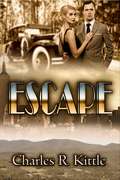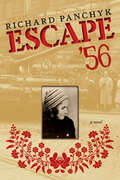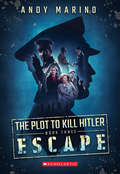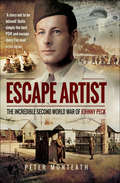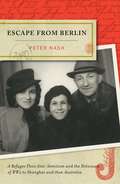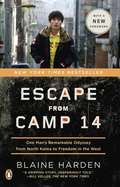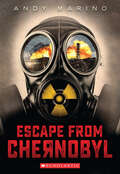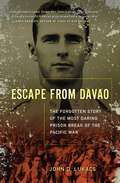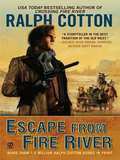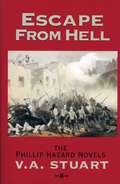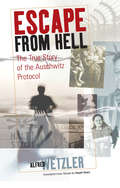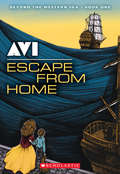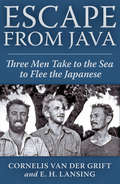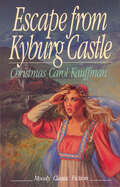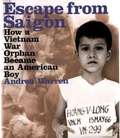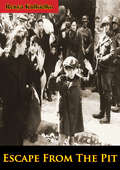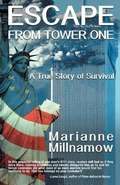- Table View
- List View
Escape
by Charles R KittleNew York speakeasy owner Drake Lauren and his sidekick Danny escape from a torrid gun chase, and in a moment of reflection, Drake takes up residence in a Massachusetts community. In a world apart from New York's wickedness, Drake senses, searches for something he can't grasp. He flounders, unfamiliar and uncomfortable with the rush of sensations he finds in this parochial New England region. Two charming but unsettling women enter his life. Though trying to resolve his New York connections he knows he can't break free of gangsters determined to eliminate him. And while searching for the path to redemption he discovers it's neither clear nor guaranteed—and complicated by women who add their demands. Drake needs a daring solution.
Escape
by Lorena MccourtneyBeth Curtis promised her brother and his wife that if anything should happen to them, she would raise their son as if he were her own. So when a double tragedy leads to their deaths at the height of the Great Depression, a brokenhearted Beth steps forward to keep her vow. However, Joey is also the grandson of Nat Wilkerson, a dangerous and wealthy tycoon, who will stop at nothing to gain sole custody of the child, sending his son Guy to find the child. Beth and her beloved nephew Joey escape by train into the night, but to her dismay, Guy follows-though not for the reasons she suspects.
Escape '56: A Novel
by Richard PanchykA dramatic historical novel of escape during occupation and wartime and of starting life over in a new country.Escape &’56 is a novel based on the life of young Elizabeth Molnár (the author&’s mother) and her family as they lived through the harrowing days of the Hungarian Revolution. The book recounts the story of the inspiring student-led uprising and the shocking Soviet invasion that followed, leading to Elizabeth&’s perilous nighttime escape from Hungary through the border woods in November, 1956. Weaving historical fact with the accounts of his relatives&’ dramatic experiences, Panchyk&’s cinematic, fictional narrative feels both personal and universal. When the Hungarian Revolution failed, more than 200,0000 Hungarians (two percent of the population) fled the country, fearing for their lives and an even more oppressive regime than they&’d already endured. Elizabeth&’s adventure continues, first as a refugee in Austria, and then in the United States where she and her family start a new life with little money, few possessions, and almost no understanding of English. Escape &’56 is a gripping novel, filled with historical detail and incorporating recollections from the author&’s mother, aunt, and grandmother.
Escape (The Plot to Kill Hitler #3)
by Andy MarinoBased on the real-life scheme to take down one of history's greatest monsters, this heart-pounding trilogy puts two courageous kids at the center of the plot to kill Adolf Hitler.July 1945.The Nazis are out for blood.After the attempt on Hitler's life, the Hoffmanns must flee Berlin. Max and Gerta, along with their mother and Kat Vogel, are forced to leave their father behind-at the mercy of the Gestapo. Following the same path that the Becker Circle used to smuggle Jewish escapees to safety, the Hoffmanns begin a desperate journey across Germany, through occupied France, and into Spain.But going on the run is incredibly dangerous, and the Nazis have invoked the blood guilt laws. Anyone thought to be connected to the assassination plot, along with their families, will be killed or sent to the camps. The Hoffmanns have friends who are willing to help them escape, but their family is still incomplete.Max can only hope that he'll see his father again.
Escape Artist (Edna Ferber Mysteries #2)
by Ed Ifkovic"Who would have thought that, of all the real-life characters to have a second life as detectives, Edna Ferber, now largely forgotten as a writer, would emerge as one of the best?" —Booklist STARRED reviewIn 1904, Edna Ferber is a 19-year-old girl reporter for the Appleton, Wisconsin, Crescent, an occupation her family considers scandalous for a proper young girl. By chance, she interviews Harry Houdini, in town visiting old friends. When beautiful young Frana Lempke disappears and is soon discovered murdered, the crime baffles the local police; Frana disappeared from a locked room at the high school. Edna asks Houdini for help in solving the murder. But as Edna pursues the story, she senses that she is being followed.Though she is dedicated to her blind father, Edna's homelife is in disorder. And now the newsroom has become a hostile environment, with a new city editor determined to undermine her....
Escape Artist: The Incredible Second World War of Johnny Peck
by Peter MonteathThe never-before-told story of World War II escape artist extraordinaire, Johnny Peck.In August 1941, an eighteen-year-old Australian soldier made his first prison break an audacious night-time escape from a German prisoner-of-war camp in Crete. Astoundingly, this was only the first of many escapes.An infantryman in the 2/7 Battalion, Johnny Peck was first thrown into battle against Italian forces in the Western Desert. Campaigns against Hitlers Wehrmacht and Luftwaffe in Greece and Crete followed. When Crete fell to the Germans at the end of May 1941, Peck was trapped on the island with hundreds of other men. On the run, they depended on their wits, the kindness of strangers, and sheer good luck.When Pecks luck ran out, he was taken captive by the Germans, then the Italians. Later, after his release from a Piedmontese jail following the Italian Armistice of 1943, and at immense risk to his own life, Peck devoted himself to helping POWs cross the Alps to safety. Captured once more, Peck was sentenced to death and detained in Milans notorious, Gestapo-run San Vittore prison until escaping again, this time into Switzerland.Historian Peter Monteath reveals the action-packed tale of one young Australian soldier and his remarkable war.
Escape From Berlin
by Peter NashA Holocaust survivor tells his compelling family story of escape and survival in China and Australia during WW2. Living in Berlin in 1939, three-year-old Peter Nachemstein and his parents were forced to escape Nazi Germany by fleeing to Shanghai – one of the only havens left for them and 18,000 other European Jews. Although safe, they became displaced and isolated from the rest of their family, who were scattered across Europe. In Escape from Berlin, Peter Nash retraces what became of his family members following the devastating impact of WW2. Using remarkable photographs and documents to bring their captivating stories to life, Peter recounts his own experiences of dislocation as a young boy in alien Shanghai, and then later as a teenager and adult in Australia. Meticulously researched and impeccably detailed, Escape from Berlin brings light to a fascinating but not widely known chapter of Holocaust history in a family story that reflects the experiences of many in the Jewish community.
Escape From Camp 14: One Man's Remarkable Odyssey from North Korea to Freedom in the West
by Blaine HardenThe heart-wrenching New York Times bestseller about the only known person born inside a North Korean prison camp to have escaped North Korea's political prison camps have existed twice as long as Stalin's Soviet gulags and twelve times as long as the Nazi concentration camps. No one born and raised in these camps is known to have escaped. No one, that is, except Shin Dong-hyuk. In Escape From Camp 14, Blaine Harden unlocks the secrets of the world's most repressive totalitarian state through the story of Shin's shocking imprisonment and his astounding getaway. Shin knew nothing of civilized existence--he saw his mother as a competitor for food, guards raised him to be a snitch, and he witnessed the execution of his mother and brother. The late "Dear Leader" Kim Jong Il was recognized throughout the world, but his country remains sealed as his third son and chosen heir, Kim Jong Eun, consolidates power. Few foreigners are allowed in, and few North Koreans are able to leave. North Korea is hungry, bankrupt, and armed with nuclear weapons. It is also a human rights catastrophe. Between 150,000 and 200,000 people work as slaves in its political prison camps. These camps are clearly visible in satellite photographs, yet North Korea's government denies they exist. Harden's harrowing narrative exposes this hidden dystopia, focusing on an extraordinary young man who came of age inside the highest security prison in the highest security state. Escape from Camp 14 offers an unequalled inside account of one of the world's darkest nations. It is a tale of endurance and courage, survival and hope.
Escape From Chernobyl
by Andy MarinoFrom Andy Marino, author of The Plot to Kill Hitler series, comes another fast-paced historical thriller chronicling one family's desperate bid to escape the deadly Chernobyl disaster. <p><p>Alina and Lev are two siblings living in Pripyat, one of the Soviet Union's proud nuclear cities. Both are asleep in their beds. Their cousin, Yuri, is a custodian at the Chernobyl Nuclear Power Plant, where he's fiercely attacking a spill in the hallway with a mop. Alina's best friend, Sofiya, sleeps just a few doors down. Her father is an engineer at the plant, a fact that has always filled her with pride. <p><p>In five minutes, Reactor No. 4 will explode in a ball of fire. It will expel radiation across their town for nine days before it's finally contained. For the people of Pripyat, it will be far too late. Two young siblings flee the Chernobyl disaster with their parents, but the Communist party is on their heels. Meanwhile, the friends and family they were forced to leave behind must contend with a disinformation campaign that's determined to pretend nothing is wrong-even as deadly radiation spills into the air.
Escape From Chernobyl
by Andy MarinoFrom Andy Marino, author of The Plot to Kill Hitler series, comes another fast-paced historical thriller chronicling one family's desperate bid to escape the deadly Chernobyl disaster.26 April 198601:18Alina & Lev are two siblings living in Pripyat, one of the Soviet Union's proud nuclear cities. Both are asleep in their beds.Their cousin, Yuri, is a custodian at the Chernobyl Nuclear Power Plant, where he's fiercely attacking a spill in the hallway with a mop.Alina's best friend, Sofiya, sleeps just a few doors down. Her father is an engineer at the plant, a fact that has always filled her with pride.In five minutes, Reactor No. 4 will explode in a ball of fire. It will expel radiation across their town for nine days before it's finally contained. For the people of Pripyat, it will be far too late.—Two young siblings flee the Chernobyl disaster with their parents, but the Communist party is on their heels. Meanwhile, the friends and family they were forced to leave behind must contend with a disinformation campaign that's determined to pretend nothing is wrong-even as deadly radiation spills into the air.
Escape From Davao: The Forgotten Story of the Most Daring Prison Break of the Pacific War
by John D. LukacsOn April 4, 1943, ten American prisoners of war and two Filipino convicts executed a daring escape from one of Japan's most notorious prison camps. The prisoners were survivors of the infamous Bataan Death March and the Fall of Corregidor, and the prison from which they escaped was surrounded by an impenetrable swamp and reputedly escape-proof. Theirs was the only successful group escape from a Japanese POW camp during the Pacific war. Escape from Davao is the story of one of the most remarkable incidents in the Second World War and of what happened when the Americans returned home to tell the world what they had witnessed. Davao Penal Colony, on the southern Philippine island of Mindanao, was a prison plantation where thousands of American POWs toiled alongside Filipino criminals and suffered from tropical diseases and malnutrition, as well as the cruelty of their captors. The American servicemen were rotting in a hellhole from which escape was considered impossible, but ten of them, realizing that inaction meant certain death, planned to escape. Their bold plan succeeded with the help of Filipino allies, both patriots and the guerrillas who fought the Japanese sent to recapture them. Their trek to freedom repeatedly put the Americans in jeopardy, yet they eventually succeeded in returning home to the United States to fulfill their self-appointed mission: to tell Americans about Japanese atrocities and to rally the country to the plight of their comrades still in captivity. But the government and the military had a different timetable for the liberation of the Philippines and ordered the men to remain silent. Their testimony, when it finally emerged, galvanized the nation behind the Pacific war effort and made the men celebrities. Over the decades this remarkable story, called the "greatest story of the war in the Pacific" by the War Department in 1944, has faded away. Because of wartime censorship, the full story has never been told until now. John D. Lukacs spent years researching this heroic event, interviewing survivors, reading their letters, searching archival documents, and traveling to the decaying prison camp and its surroundings. His dramatic, gripping account of the escape brings this remarkable tale back to life, where a new generation can admire the resourcefulness and patriotism of the men who fought the Pacific war.
Escape From Fire River
by Ralph CottonLawrence Shaw is known as the fastest gun alive. But after recovering a fortune in stolen gold, being fast may not be enough. Garris ?The Cat? Cantro and his Border Dogs are remnants of the Confederacy who will fight, steal, and kill to the last man. And with all that gold, they can declare war on all who stand against them. Which is why Shaw is going to make his stand right now. .
Escape From Hell
by V. A. StuartWith the Sepoy Mutiny still threatening British lives in India, Commander Phillip Hazard volunteers to accompany a special army force to rescue the besieged British garrison at Ghorabad. Hazard and the men of the Shannon's Naval Brigade are put under the command of Colonel Cockayne, a cavalry officer whose own wife and daughter are among those caught in the siege. In this final book of the Hazard series, Hazard finds himself in the thick of the battle, desperately trying to rescue survivors and facing the dangers and betrayals that come with command and war.
Escape From Hell: The True Story of the Auschwitz Protocol (Berghahn Series)
by Alfred Wetzler"Alfred Wetzler was a true hero. His escape from Auschwitz, and the report he helped compile, telling for the first time the truth about the camp as a place of mass murder, led directly to saving the lives of 120,000 Jews: the Jews of Budapest who were about to be deported to their deaths. No other single act in the Second World War saved so many Jews from the fate that Hitler and the SS had determined for them. This book tells Wetzler's story." · Sir Martin Gilbert "Wetzler is a master at evoking the universe of Auschwitz, and especially, his and Vrba's harrowing flight to Slovakia. The day-by-day account of the tremendous difficulties the pair faced after the Nazis had called off their search of the camp and its surroundings is both riveting and heart wrenching. [...] Shining vibrantly through the pages of the memoir are the tenacity and valor of two young men, who sought to inform the world about the greatest outrage ever committed by humans against their fellow humans." · [From Introduction by Dr Robert Rozett] Together with another young Slovak Jew, both of them deported in 1942, the author succeeded in escaping from the notorious death camp in the spring of 1944. There were some very few successful escapes from Auschwitz during the war, but it was these two who smuggled out the damning evidence – a ground plan of the camp, constructional details of the gas chambers and crematoriums and, most convincingly, a label from a canister of Cyclone gas. The present book is cast in the form of a novel to allow factual information not personally collected by the two fugitives, but provided for them by a handful of reliable friends, to be included. Nothing, however, has been invented. It is a shocking account of Nazi genocide and of the inhuman conditions in the camp, but equally shocking is the initial disbelief the fugitive’s revelations met with after their return.
Escape From Home: Escape From Home (Beyond the Western Sea #1)
by AviAvi's suspense-filled, seafaring adventure gets a bold new package!It's 1851. Fifteen-year-old Maura O'Connell and her twelve-year-old brother Patrick are about to set sail on an epic voyage to America to flee the brutal poverty of Ireland and to be reunited with their father.Eleven-year-old Laurence Kirkle, the son of an English lord, runs away from home to escape his cruel older brother and start a new life in a new world.All three children face nothing but obstacles along the way--from stolen money to con men to hunger and fatigue. It seems that none of them will get out of the port city of Liverpool until fate brings them together. Avi's masterful plot-spinning skills create an adventure filled with unexpected twists and turns.
Escape From Java
by Cornelis van der Grift E. H. LansingEscape from Java, first published in 1943, recounts the Japanese invasion and occupation of Java (a Dutch colony at the time and now part of Indonesia) during World War Two. The authors describe their experiences under Japanese rule, then decide to escape the island in a small fishing boat. They take to the sea and travel across west across the vast Indian Ocean until they eventually reach a British outpost on the island of Rodrigues in the Indian Ocean. Escape from Java provides a in-depth look at life under Japanese rule and the factors that drove the men to risk everything to escape to freedom. Included are 7 pages of illustrations.
Escape From Kyburg Castle
by Christmas Carol KauffmanAnxious, trying times describe Switzerland in the early 1500s.Large numbers of Anabaptists are imprisoned. In fact, Kyburg Castle is full. Yet they won't fight. The more they are punished, the larger their group becomes.And Regina wonders...A mandate demands the drowning of anyone who rebaptizes another. But the Anabaptists continue to do so. What's more, they won't reveal who baptized them, even at the threat of torture.And Regina wonders...She wonders why more and more good people are risking their lives by abandoning the state religion. She wonders if indeed her spiritual welfare was taken care of when she was an infant. She wonders how the captivating Peter Reimann can justify leading prisoners up the hill to the tower prison.She wonders, becomes informed, then makes a decision.
Escape From Kyburg Castle
by Christmas Carol KauffmanAnxious, trying times describe Switzerland in the early 1500s.Large numbers of Anabaptists are imprisoned. In fact, Kyburg Castle is full. Yet they won't fight. The more they are punished, the larger their group becomes.And Regina wonders...A mandate demands the drowning of anyone who rebaptizes another. But the Anabaptists continue to do so. What's more, they won't reveal who baptized them, even at the threat of torture.And Regina wonders...She wonders why more and more good people are risking their lives by abandoning the state religion. She wonders if indeed her spiritual welfare was taken care of when she was an infant. She wonders how the captivating Peter Reimann can justify leading prisoners up the hill to the tower prison.She wonders, becomes informed, then makes a decision.
Escape From Pompeii
by Christina BalitThe eruption of Mount Vesuvius in AD 79 destroyed Pompeii, but some people must have survived. Taking this historical event as a starting point, this story tells of Tranio, an actor's son, and his friend Livia, the baker's daughter, as they witness the destruction of their beloved city.
Escape From Saigon: How a Vietnam War Orphan Became an American Boy
by Andrea WarrenAn unforgettable true story of an orphan caught in the midst of war Over a million South Vietnamese children were orphaned by the Vietnam War. This affecting true account tells the story of Long, who, like more than 40,000 other orphans, is Amerasian -- a mixed-race child -- with little future in Vietnam. Escape from Saigon allows readers to experience Long's struggle to survive in war-torn Vietnam, his dramatic escape to America as part of "Operation Babylift" during the last chaotic days before the fall of Saigon, and his life in the United States as "Matt," part of a loving Ohio family. Finally, as a young doctor, he journeys back to Vietnam, ready to reconcile his Vietnamese past with his American present. As the thirtieth anniversary of the end of the Vietnam War approaches, this compelling account provides a fascinating introduction to the war and the plight of children caught in the middle of it.
Escape From Slavery: A Family's Fight for Freedom (Barbour Book's The American Adventure, Book #16)
by Norma Jean LutzTim Allerton is angry. At school, Hollis Bodley tries to outdo Tim in everything and openly makes fun of Tim's anti-slavery views. At home, Tim's father constantly reminds him to keep his opinions to himself because their family business depends on customers from the South. Pam, Tim's younger sister, doesn't understand why he has a problem with slavery in the first place. "Slaves are treated just like family," she says. Then Tim and Pam are put into a situation where they can save the life of a slave baby whose mother has just been killed. Will Pain change her views on slavery . . . or will she continue to ignore the problem? And when a move to drive black people out of the section of the city called "Little Africa" puts Tim's good friend Ward Baker in danger, how can he help?
Escape From The Pit
by Renya KulkielkoBorn near Kielce of ill-fated memory, Renya Kulkielko and her two brothers (now in Displaced Persons camps) are the sole survivors of a family of eight. Reading this tragic and exciting book will explain why she is fortunate in still having two brothers - and in being alive and at work in a Palestine kibbutz! World War II broke out when Renya Kulkielko was only fifteen. The days of horror that followed, her ghastly experiences in ghettos, concentration camps and prisons, are described in dramatic detail. The tale of her escapes from death - that can only be described as miraculous - and of her final departure for Eretz Israel gives us a book that fills our eyes with tears and our hears with pain. "Can human beings be guilty of such acts of studies and continuous cruelty as were the Nazis in Poland and throughout Europe?" we ask ourselves. The answer is yes: and also that humans can rise to such heights of steadfastness and heroism as did so many of the Jews described in Escape from the Pit.--Print Ed.
Escape From Tower One: The True Story of How Vincent Borst Survived the 9/11 Attack on the World Trade Center and Led Others to Safety From the 82nd Floor of the North Tower
by Marianne MillnamowThe true story of Vinnie Borst, an employee of the Port Authority, who survived the 9/11 Attack on the World Trade Center and led others to safety from the 82nd floor of the North Tower. A compelling account of one man's heroic actions in the face of tragedy. A third of the proceeds from the sale of this book will go to two funds: the Edward T. Strauss Memorial Fund (www. WithEddiesHelp. org) to assist those with disabilities and combat homelessness AND the Aspiring Kindness Foundation, a 501(c)(3) not-for-profit public corporation that provides financial assistance to support and enhance the abilities of emergency responders and service providers (www. aspiringkindness. org).
Escape From the Ghetto: The Breathtaking Story of the Jewish Boy Who Ran Away from the Nazis
by John Carr'Trust me, this is a great true story' - Ken Follett'This is an unbelievable story that is all completely true. The life described is astonishing. John Carr has done an extraordinary and riveting job uncovering the real father behind the dad he thought he knew.' - Lord Tony Hall'Utterly Compelling. It is an extraordinary tale, brilliantly written' - Alastair Stewart'Extraordinary. An adventure story in the most terrible circumstances, a kid facing the most desperate dangers but taking fantastic risks with great boldness' - Fiona MacTaggart'The remarkable story of a Jewish boy who killed a Nazi guard and escaped the Holocaust aged 13' - The Times'Unputdownable. A gripping, life affirming story of survival against seemingly impossible odds.' - Deborah Cadbury, author of Prince at War~~~~~The captivating true story of one boy's flight across Europe to escape the Nazis. A tale of extraordinary courage, incredible adventure, and the relentless pursuit of life in the face of impossible challenges. In early 1940 Chaim Herszman was locked in to the Lódz Ghetto in Poland. Hungry, fearless and determined, he goes on scavenging missions outside the wire limits, until he is forced to kill a Nazi guard. That moment changes the course of his life, and sets him on an unbelievable adventure across enemy lines. Chaim avoids grenade and rifle fire on the Russian border, shelters with a German family in the Rhineland, falls in love in occupied France, is captured on a mountain pass in Spain, gets interrogated as a potential Nazi spy in Britain, and eventually fights for everything he believes in as part of the British Army. He protects his life by posing as an Aryan boy with a crucifix around his neck, and fights for his life through terrible and astonishing circumstances. Escape from the Ghetto is about a normal boy who faced extermination by the Nazis in the ghetto or a Nazi deathcamp, and the extraordinary life he led in avoiding that fate. It's a bittersweet story about epic hope, beauty amidst horror, and the triumph of the human spirit.John Carr is Henry Carr's eldest son, and in Escape From the Ghetto he has recreated his father's incredible adventure, through recordings and transcribed conversations in later life.For fans of The Tattooist of Auschwitz, The Saboteur of Auschwitz and The Volunteer, this is the incredible true story of escape from the Nazis during World War II.
Escape From the Ghetto: The Breathtaking Story of the Jewish Boy Who Ran Away from the Nazis
by John Carr'Trust me, this is a great true story' - Ken Follett 'It deserves to be ranked among the great survival stories of the Second World War' - The Jewish Chronicle ~~~~~ The captivating true story of one boy's flight across Europe to escape the Nazis. A tale of extraordinary courage, incredible adventure, and the relentless pursuit of life in the face of impossible challenges. In early 1940 Chaim Herszman was locked in to the Lódz Ghetto in Poland. Hungry, fearless and determined, he goes on scavenging missions outside the wire limits, until he is forced to kill a Nazi guard. That moment changes the course of his life, and sets him on an unbelievable adventure across enemy lines. Chaim avoids grenade and rifle fire on the Russian border, shelters with a German family in Berlin, falls in love in occupied France, is captured on a mountain pass in Spain, gets interrogated as a potential Nazi spy in Britain, and eventually fights for everything he believes in as part of the British Army. He protects his life by posing as an Aryan boy with a crucifix around his neck, and fights for his life through terrible and astonishing circumstances. Escape from the Ghetto is about a normal boy who faced extermination by the Nazis in the ghetto or a Nazi deathcamp, and the extraordinary life he led in avoiding that fate. It's a bittersweet story about epic hope, beauty amidst horror, and the triumph of the human spirit. John Carr is Henry Carr's eldest son, and in Escape From the Ghetto he has recreated his father's incredible adventure, through recordings and transcribed conversations in later life. For fans of The Tattooist of Auschwitz, The Saboteur of Auschwitz and The Volunteer, this is the incredible true story of escape from the Nazis during World War II. REVIEWS 'John Carr deserves our gratitude for rescuing this World War Two story, among the most dramatic and vivid I've read.' - Edward Stourton, author of Cruel Crossing 'This is an unbelievable story that is all completely true. The life described is astonishing. John Carr has done an extraordinary and riveting job uncovering the real father behind the dad he thought he knew.' - Lord Tony Hall 'Utterly Compelling. It is an extraordinary tale, brilliantly written' - Alastair Stewart 'Extraordinary.'- Fiona MacTaggart 'The remarkable story of a Jewish boy who killed a Nazi guard and escaped the Holocaust aged 13' - The Times 'Unputdownable. A gripping, life affirming story of survival against seemingly impossible odds.' - Deborah Cadbury, author of Prince at War 'This is a book you cannot put down... Passionate and spellbinding, and an absolute must read.' - Julia Neuberger "John Carr's book gives a truly riveting account of his teenage Dad's life on the run in Nazi-occupied Europe. It serves as a reminder of the cruel and arbitrary realities of the refugee experience. It won't be on Priti Patel's reading list but it should be on yours." - Jon Bloomfield "An eloquent tribute to courage and resourcefulness, Escape from the Ghetto, is a gripping page turner." - Esther Safran Foer "One of the most extraordinary books I have ever read" - Michael Dobbs, author of House of Cards
